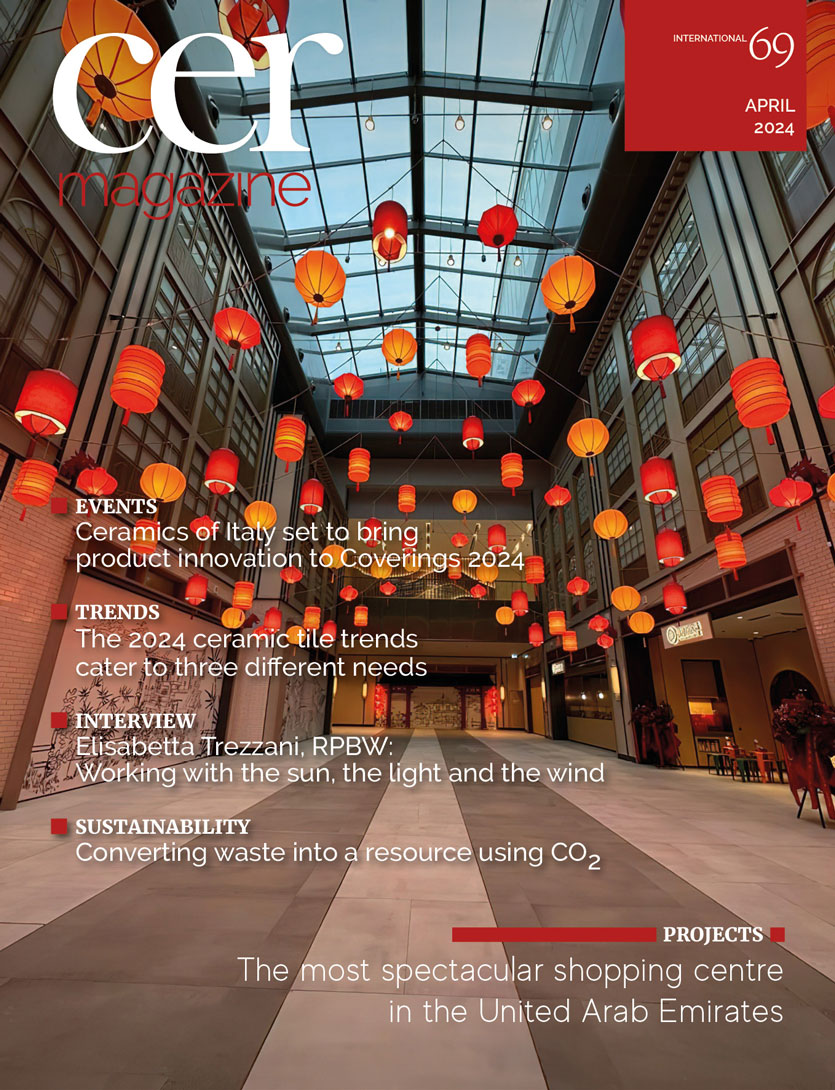Alchimia and ceramic tiles
“Constantly poised between expressivity and functionalism, ceramic tiles aim to transcend linguistic barriers and the rigid boundaries of painting, craftsmanship, design and architecture,” (cit. Alessandro Guerriero, co-founder of Alchimia in 1976 together with Adriana Guerriero).
(April 2024) | In the late 1970s and early 1980s, Milan’s design studios were a melting pot of ideas, innovation and research, attracting many young people, including non-Italians, who were drawn to the creative energy and the presence of renowned architects. It was not uncommon to simply knock at a studio’s door and introduce oneself, hoping to connect with someone inside. Although the people arriving at these studios tended to be newcomers to the city rather than local residents, they often boasted experience and well-established positions in their fields.
The author of this article did precisely this on one occasion when he and Antonella Cimatti decided to knock at the door of Alchimia’s studio in Via Fratelli Gabba. They brought with them their local knowledge of Faenza (Ravenna), a modest amount of industrial experience from Sassuolo and other places, a basic artistic education, ceramic expertise, connections and a desire to immerse themselves in the intensely vibrant, contemporary cultural and design scenes unfolding at the time.
The Italian design approach embraced by Alchimia, which was initially part of the Radical Architecture movement, and likewise by Memphis, Zeus, Tendentse, Ollo Design and many others, sparked considerable excitement that transcended national borders, making its way to France. There, it infused a Post-Modern spirit into Parisian design culture1. At the same time, initiatives like Piastrelle italiane “Ieri e Domani” (Italian Tiles “Yesterday and Tomorrow”)2 generated considerable enthusiasm.
In 1982, DOMUS magazine dedicated two issues to architectural ceramics, the first highlighting the work of Toscoceramica3 and the second that of Appiani/Bonicalzi from Alchimia/Centrokappa4. This focus underscored a burgeoning synergy between design culture, production and entrepreneurship and marked a pinnacle of new alliances in the field. At that time, under the editorship of Alessandro Mendini, Domus documented the ever-evolving landscape of architecture and art5, reflecting the shifting dynamics of contemporary culture.
This surge of innovative ideas spurred further initiatives across Italy. In the spring of 1982, for example, the State Art Institute in Forlì hosted luminaries such as Enzo Mari, Aldo Rossi, Achille Bonito Oliva and Bruno Munari for discussions with students.
In the field of ceramic sculpture, Filiberto Menna conceived and curated the exhibitions “DE SCULPTURA I and II” in 1984 and “Il Cotto e il Crudo” held in Caltagirone.
During this period, the International Museum of Ceramics in Faenza (MIC) set up a collection of contemporary tiles based on an idea that first originated in the latter half of the 1970s. The collection included prototypes and signed productions and subsequently underwent rapid growth. In 1978, Bruno Munari further expanded the MIC’s offerings by founding a children’s ceramics workshop entitled Giocare con l’Arte (“Playing with Art”). Other notable initiatives from this period include Neomerce in 1985 at the Triennale di Milano and Abitare il Tempo in Verona.
On the evening of Tuesday, 20 September 1982, the exhibition Sogno erotico di una notte di mezza estate (“A Midsummer Night’s Erotic Dream”) opened at the Armando Bonicalzi showroom in Solbiate Olona. This event was promoted by Bonicalzi and organised by Appiani Ceramiche, while the project was designed by Stefano Casciani, Carla Ceccariglia and Bruno Gregori from Studio Alchimia/Centrokappa. The exhibition was accompanied by a performance by Giancarlo Soldi from Centrokappa Visual Production.
In particular, the exhibition featured a work entitled Stanza di Desdemona (“Desdemona’s Room”), a four-part installation including a base and walkway, two side walls and a relief-decorated back wall. It featured 20×20 cm cottoforte ceramic tiles produced by Appiani and displaying Alchimia’s distinctive design style, in shades of grey, white and light blue, applied using silkscreen and stencil techniques. Desdemona’s Room showcased contemporary design objects, including the “Vanity Fair” armchair (designed by Archivio Storico Frau and produced by Poltrona Frau), the “Hall” lamp (designed by Carlo Chambry and produced by Venini) and Luca Alinari’s 1982 painting “Cunicolo a ritroso”, along with Mali Tricot’s dress sculpture and Cinzia Ruggeri’s “Indumento Assonometrico” leather dress, offering a glimpse into the contemporary and avant-garde. The performance involved “veiled young women dancing around a handsome male dancer to classical music played at high volume”, as recalled by Mariangela Bonicalzi.
As proposed by the author (who was then a designer for Bonicalzi/Kerstone), the exhibition was dismantled and partially donated to the Museum of Assopiastrelle (later Confindustria Ceramica) founded in Sassuolo (MO) in 1995, with exhibits designed by Marco Zanini and Marta Sansoni. Another portion was donated to the International Museum of Ceramics in Faenza, contributing to the growth of its contemporary tile collection in size, significance and uniqueness. Pieces from this collection remain on display in both museums, and the work is catalogued at the Emilia Romagna Cultural Heritage Institute, PatER.
Alchimia’s work in the field of ceramics extended to objects such as marked white earthenware vases showcased in Milan and various trade fairs, as well as other projects in Faenza. These included “La Stanza Infelice” (P.C. Bontempi, A. Guerriero), presented in the Sala Consigliare of the City Hall in January 1984, during a conference entitled “Design and stylistic aspects of tile decorations”.
Alchimia also organised two workshops conducted by Alessandro Guerriero at the Ballardini Institute in Faenza, “Totemone” in 1997 and “Viso-Vaso” in 2000, which actively engaged with students and teachers. This led to the production of numerous works that are now catalogued and housed in the MISA, the institute’s permanent museum established in 2008.
Furthermore, Alchimia designed the decorative scheme for the “Oscar della Ceramica” award assigned in 2003 in memory of sculptor and designer Alfonso Leoni of Villeroy & Boch.
Alessandro Guerriero, winner of the Compasso d’Oro award in 1982, discussed the origins of Alchimia’s distinct stylistic features during a lecture given at the ABA of Brera in 2013 entitled Technology of Materials for Restoration (Arcore, there exists a probably partial recording of the event). He also participated in a seminar at the Milan Polytechnic on 27 May 2023, entitled “Architectural Ceramic Materials. Knowledge and Conservation”, directed by Assunta Maria Oteri together with Michela Marisa Grisoni, with architect Franco Raggi also in attendance.
Guerriero’s contributions also include a tile designed for the 5th Biennial Ceramics Exhibition held at the Ceramics Museum of Fiorano Modenese in 2005, as part of a collection with Giuliano Della Casa, Pablo Euchaurren, Paola Navone, Mimmo Paladino and Bottega Gatti. The exhibit was designed by architect Giovanni Levanti.
“Alchimigrafo”, another famous design from Atelier Alchimia, was also displayed during this event and is preserved in the Historical & Contemporary Archive.
Notes
1 New groups and collections were showcased in the city during “Eau et Carreau”, held at the CCI – Centre de Création Industrielle, Centre Georges Pompidou in 1985, accompanied by a catalogue citation. The event also featured video projection images and projects from Italy, drawn from Disegno & Design, 1984, published by EDI.CER.
2 Italian Cultural Institute Tokyo, catalogue with Giorgio De Marchis, Masayoshi Endo, promoted by Masahiko Shibatsuji, 1982.
3 Domus 632 October 1982, repetitive wall design by Alessandro Mendini.
4 Domus 634 December 1982, “Stanza Onirica” designed by Occhiomagico.
5 Domus 634 December 1982, “Transavanguardia” by Achille Bonito Oliva and Nicola De Maria p. 67.
Sources and Acknowledgments
Directorate, Library and Elena Dal Prato, MIC Faenza
Maria Teresa Rubbiani and Matteo Ruini, Confindustria Ceramica
Mariangela and Veronica Bonicalzi
Liceo Artistico Torricelli Ballardini, Faenza
Stefania Spaggiari, Alessandra Alberici and Giorgio Montanari, Museo della Ceramica Fiorano Modenese
Archivio Storico & Contemporaneo Giovannini, Faenza
*Rolando Giovannini, is a geologist with a diploma in decoration from the Academy of Fine Arts in Bologna and a former contract lecturer at ABA Brera and SSBAP Politecnico Milano. He was involved in creating and studying the architectural ceramics collections at the International Museum of Ceramics (MIC) in Faenza, the Museum of Ceramics in Raito, Vietri sul Mare (riggiole), the Contemporary Section of the Museum of Ceramics in Fiorano Modenese, the Confindustria Ceramica Museum in Sassuolo, the MUST Historical Museum of Technology in Imola, and the MISA didactic collection at the Ballardini Institute in Faenza. He is a member of the International Academy of Ceramics (IAC) in Geneva and the Order of Journalists in Rome. He contributed to the organisation of the Museo del Design Italiano at the Triennale Milano, which runs from April 2023 to 2025.














